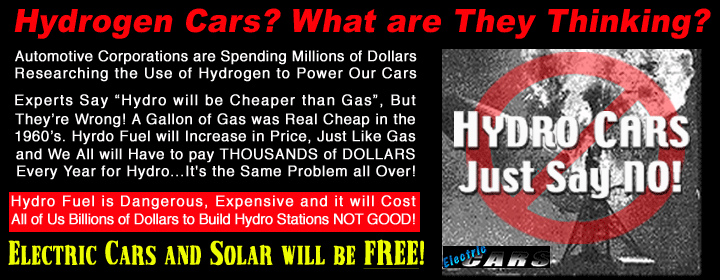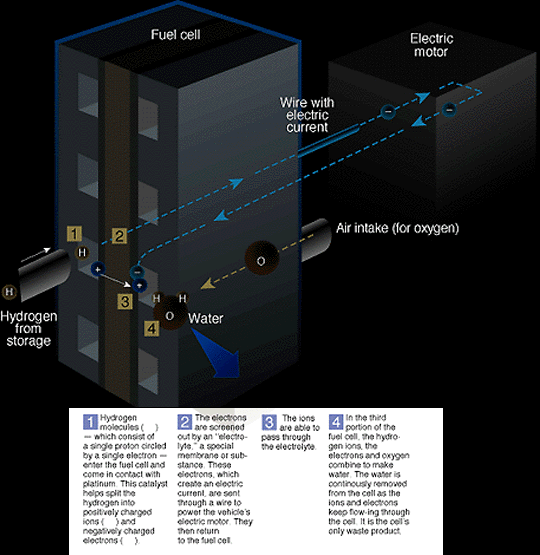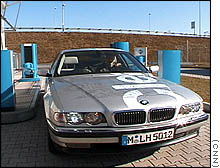Hydrogen Powered
Vehicles
2003 Now I know that trying to
predict the future is hard, but I reckon that an electric
car, powered by a fuel cell running on hydrogen, could be a
goer! If you remember back to your chemistry classes at
school, water is H2O. In other words, a molecule
of water is made up of two atoms of hydrogen, and one atom
of oxygen. If you use energy, and pass electricity through
water, you can split water into hydrogen and oxygen. And you
can run this reaction backwards, and combine hydrogen and
oxygen to give you water and energy. (In fact, the word,
"hydrogen", means "maker of water" in the original Greek
language.) There are two main ways
that you can burn hydrogen with oxygen, to give you water,
and energy. The first way is that you
can burn hydrogen in a modified car engine. Two companies,
BMW and Mazda, are working on this. The engine works fine,
but with about 20% less power - which is pretty reasonable,
considering that we have been working on the petrol engine
for a century or so. When you burn hydrogen in an engine,
you get mostly water coming out of the tailpipe. You also
get small amounts of oxides of nitrogen (from the nitrogen
in the air), and even smaller amount of hydrocarbons (from
traces of the lubricants in the combustion chambers of the
engine). Even so, a hydrogen-powered car is much less
polluting than a petrol-powered car. Of course, you use a
normal gearbox and diff. The second way to use
hydrogen to run your car is in an electric car.
Mercedes-Benz have been using a strange device called a fuel
cell, which has been around since 1839. A fuel cell is very similar
to a battery. Both a fuel cell and a battery turn a chemical
reaction into electrical energy. But a battery is sealed,
and when the "goodness" in the chemicals is used up, the
battery is flat. A fuel cell is like a battery, but with one
important different difference - you can pump in the
chemicals indefinitely. Fuel cells take in hydrogen and
oxygen, and give off pure drinking water, and electricity.
You use the electricity to run electric motors. Fuel cells are up to 80%
efficient. They will get two or three times more energy out
of hydrogen, than will a modified car engine. This is
because the internal combustion engine has a stage where you
generate a lot of heat - and this is where a lot of energy
is wasted, and where the efficiency goes right
down. The real problem with
today's electric cars is that our battery technology is
pathetic. The battery pack in today's best electric car, the
EV-1, gives great acceleration, but a range of less than 100
kilometres. But if you use a fuel cell instead of a battery,
you suddenly get an electric car with very low pollution,
and good range and performance. There are two main ways to
store hydrogen in your car-of-the-future. First, you can
squash it and turn it into a liquid - but the container has
to be very strong and heavy, and you have to insulate it to
keep it at a temperature of about 260oC below
zero. The second way is to shove
the gas into a metal, such as magnesium, and it will squash
into the spaces between the magnesium atoms. It sounds
unbelievable, but you can actually store more hydrogen
inside a metal, than you can as a liquid. Nelly Rodriguez
and her fellow scientists at Northeastern University in
Boston claim that they can do even better. They used
incredibly thin sheets of graphite only one third of a
billionth of a metre apart, and they reckon that they can
store 30 litres of hydrogen on a single gram of graphite,
which works out to an amazing 8,000 kilometres per tank,
with your hydrogen-powered car. Either way, you can fill
your tank in under three minutes - which is not much
different from filling up with petrol. One problem with hydrogen
is the bad public relations angle - most of us have heard of
hydrogen bombs, and seen the dramatic footage of the
hydrogen-filled Hindenberg airship exploding in 1937. But
hydrogen can be stored safely - in a series of tests on a
tank of liquid hydrogen, BMW played flames at 900oC on it
for 70 minutes, punched holes into it, and even squashed it
until it broke. Sometimes the hydrogen leaked out, and
sometimes it caught alight, but it never
exploded. At the moment, in the USA
alone, there's about $200 billion invested in shifting and
storing petrol, and it would take an enormous effort to
start dealing with hydrogen.BMW has 15 of the 750hL sedans
participating in its Clean Energy road show. Combined, the cars have
traveled more than 63,000 miles, (100,000 kilometers). But
with just one place to "fill up," hydrogen cars are now
practical only in and around Bavaria, near the Munich
filling station. Right now, the car's range is limiting:
just 217.5 miles (350 km). The hydrogen sedans are not on
the market yet, but BMW is already considering ways to
broaden their sales possibilities. One of the company's goals
is a hydrogen filling station in every European capital by
2005. Mass acceptance? Years of promoting mass transit have
not ended love affairs with the car in any industrialized
country. So the mindset now in some transportation circles
and smoggy city governments is to at least get drivers into
low- or non-polluting vehicles. "I won't argue about whether
this will happen in 30 years, 40 years, or 50 years ... but
it WILL happen," says Professor Ulrich Wagner of Munich's
Ludwig Maximilian University. Wagner says car and energy
companies, as well as local and national governments, must
work on a common path to make hydrogen-fueled cars a
reality. "We need better storage systems, more efficient
storage systems, and we need a certain infrastructure in
order to get started," said Wagner, who teaches courses on
renewable energy. While hydrogen is the
lightest element, it has some tricky characteristics. It
only becomes liquid at dramatically low temperatures -- -423
degrees Fahrenheit (-253 degrees Celsius). To keep the fuel
that cold, fuel tanks in the BMW cars are made of 70 layers
of fiberglass and aluminum. Hydrogen fuel is now created
through an electrolysis process. Electrodes are stimulated
by light, which split water molecules into hydrogen and
oxygen. What
about safety? Safety issues are a major
concern for a fuel that's often perceived as more dangerous
than others. While hydrogen itself played no part in either
catastrophe, it was the fuel in both the Hindenburg and the
Challenger. Wagner says consumers should not fear a
hydrogen-powered vehicle. "Of course there is some risk, but
it is comparable to the risk we have with conventional
automotive fuels," he said. BMW conducted numerous crash
tests to see what would happen if the hydrogen tank was
punctured or damaged. Their engineers report the
liquid hydrogen dissipated harmlessly into the air. What, if
anything, will provide a kick-start for hydrogen or other
alternative fuels? It could be economic, with the cost of
gasoline now topping $4 a gallon in much of Europe. Or it
could be political, like California's tough emissions
standards. Or, in clogged cities that already have serious
smog problems, health issues could tip the scale toward
developing cleaner energy sooner, rather than later. "You
start with fleet and other specialized applications, like
airport buses, or transporting VIP's," says Jim Ohi, a
hydrogen expert at the National Renewable Energy Laboratory
in Colorado. "In the U.S. there are also federal programs,
clean city programs, that mandate alternative vehicles for
part of government fleets." Ohi says there's a reason "oil
companies" are now referring to themselves as "energy
companies: "They're feeling the pressure to study
zero-emission fuels, even if it may be decades before they
make any money with it." "We have problems with our C02
emissions concerning the climate," says BMW's Pehr.
"Especially with big cities. Look at Mexico City (Mexico),
Athens (Greece), or Los Angeles (California). Hydro supporters feel we
can solve these problems just by a new energy carrier in the
future." A few pilot projects using hydrogen fuel exist in
the United States. Several are in California, where
residents are more in tune with energy alternatives such as
solar and wind power for electricity generation. And because
of recent rolling blackouts and enormous increases in
electric costs, perhaps more open to looking beyond current
technology. The world probably won't
get a hydrogen energy economy in the near future - but we
might further down the line, as we begin to run out of
fossil fuels.

The trouble with today's
cars is that they still put out a lot of pollution, and use
up fossil fuels. One day, we have to run out of fossil
fuels. People have been talking about running cars on water
for ages. Unfortunately, most of the time, these people are
crackpots. But there is a certain amount of truth in what
they say.


Information is based on specs
provided by manufacturer and may change without notice.
ElectricCars.net is not responsible for accuracy of
this information and does not guarantee the operational factors,
mechanical workings or financial outcome of the use of any
vehicle.
Layout, design
& Content Copyright © 1997-2010 ElectricCars.net. All rights
reserved Please read Terms
of Usage